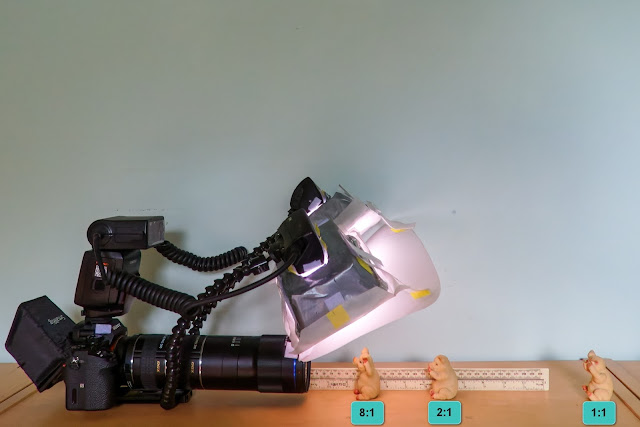I think I have reached the limit of the depth of field I can get from single shots. I might get more in due course if the software I am using improves or I get better at using the software. For the moment though the limit appears to be at around f/45 when using a pair of 2X teleconverters with the Laowa 100mm 2X macro. (That f/45 is for the camera/lens - the lens is set to f/11 and the camera knows that there is 4X teleconversion in use and adjusts that f/11 to f/(11*4), and shows an f-number of f/45).
I have two reasons for thinking that this is the limit.
First, I did a session with f/57, which is two thirds of a stop up from f/45, and I didn't want to keep any of the images from the session. Despite the heavyweight processing they were still too soft for my liking and lacked some detail that I had been getting in similar shots at f/45, for example in ants' eyes.
Second, a very helpful and insightful analysis of one of my tiny aperture images by Rik Littlefield. Rik is immensely knowledgeable in this area. He is I believe the author of Zerene Stacker, which is one of the two highly specialised focus stacking software applications. He also runs the photomacography.net web site. Rik is very actively involved with discussions on the web site and has a talent for explaining complicated issues in accessible language for people (like me) who don't have the background to understand the underlying optics and mathematics.
Rik's analysis was in this thread, in which I had posted five of my recent tiny aperture images. (I don't post much on that site, but I'm very glad I did this time round.) Another forum member asked me to do a comparison between a focus-stacked image and one of my tiny aperture images of the same subject, which I did. (I'm not very skilled at focus stacking at the macro scale, but fortunately what I managed was good enough for the purpose in hand.)
In this post Rik did a detailed comparison of a couple of areas in the images and showed that even at the reduced image size of 1300 pixels high it was not just that the tiny aperture image was losing fine detail, but that for the detail that remained it was rearranging some elements of it so that it was different from the actual structure of the subject. However, you had to look very carefully at a like for like comparison with a more accurate rendition to tell this was going on. As Rik put it,
I don't see that any of this impacts Nick's use of this technology for his purposes. Small aperture one shot is the only technique I know for capturing high DOF images of small active critters. But it does seem clear that this image has reached beyond the limit of accurately capturing fine detail, even at the 1300 pixels size.
I'm content to live with this fine detail inaccuracy as it doesn't in my view significantly alter the overall impression of the scene and the subject. And given my approach of "pretty pictures" and "credibility" rather than "accurate records" and "authenticity" I think that is good enough. But, coupled with my f/57 experience, I do think I'll draw the line at f/45 for now.
The curious issue remains that using a constant camera/lens f-number of f/45 seems to work even though this means that the effective f-number is changing as the magnification changes, and so the depth of field and diffraction softening are changing too. Why this constant f-number should work is a mystery to me. It may be that I haven't looked at this carefully enough. I'll try some more variations away from f/45 to see if I can get more depth of field at some magnifications. If I can then I can adopt a more nuanced approach to setting the camera/lens f-number, although to be honest the simplicity of using a single f-number is very appealing because it lets me react faster to what is going on.
Update 28 May 2021.
User ThrillaMozilla has commented very helpfully on this mystery in this post at dpreview.com:
ThrillaMozilla wrote:
gardenersassistant wrote:
It is very convenient to not adjust the aperture as the magnification changes. Given that this means the effective aperture changes with magnification, I don't understand why this works as well as it does in terms of apparently (difficult to test) getting a similar depth of field in relation to subject size whatever the magnification.
Image-side geometry to the rescue.
It's late, but if I did the math. correctly on the small scrap of paper, for a given focal length the diffraction blur diameter and the depth of field are both proportional to 1+1/M. How convenient. You want them both to stay proportional to the size of the sample, hence constant with changes magnification. For M between 1.5 and 5.6 that varies between 1.18 and 1.67 -- thus constant enough. It's just your good luck that it works out that well.











































